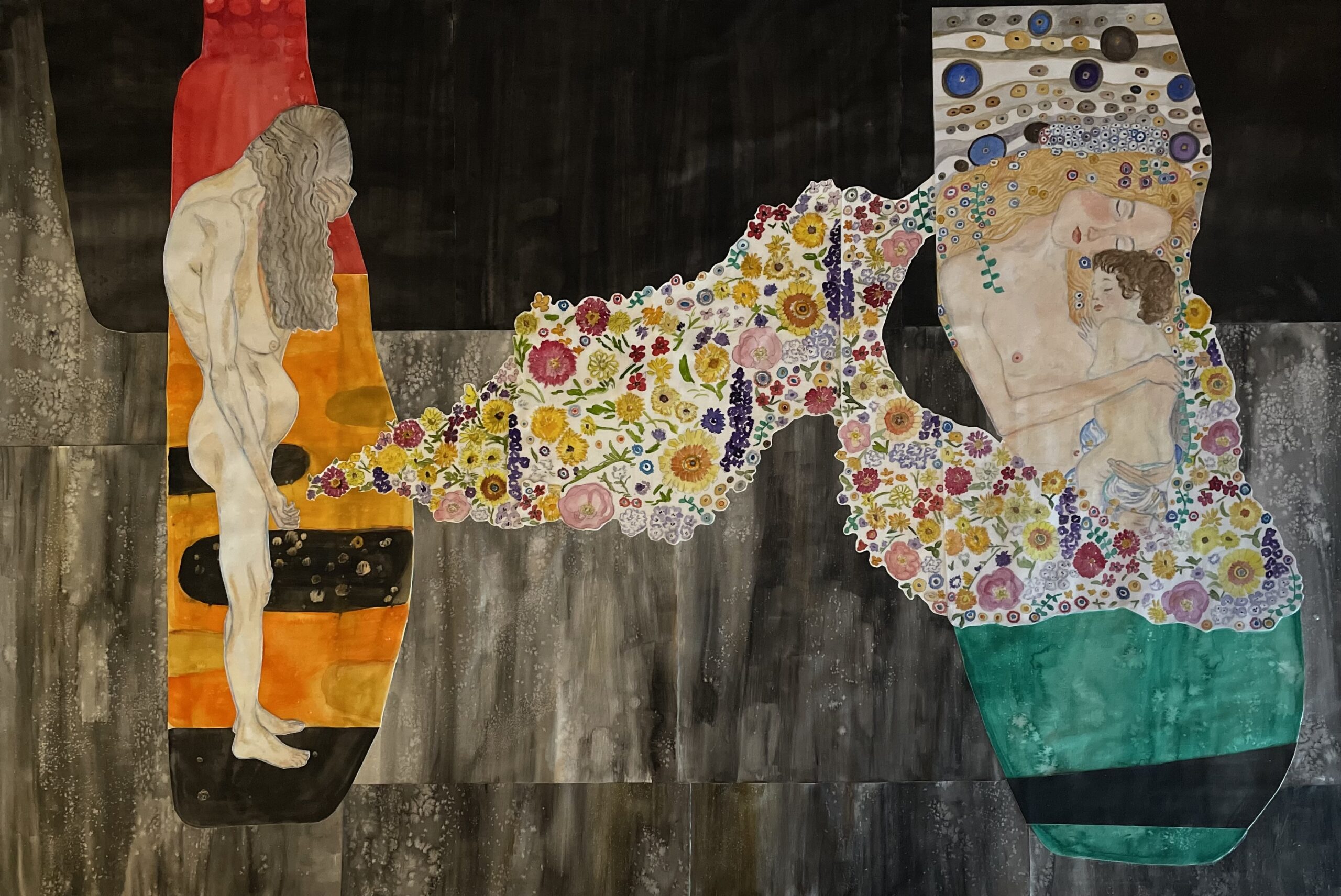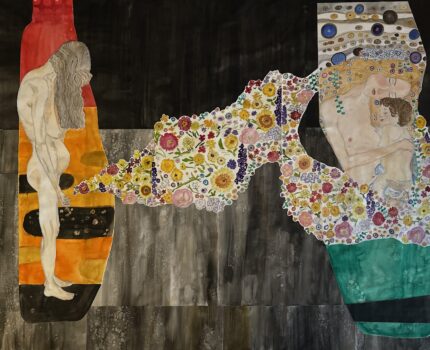For my STEAM project, I chose to relate my topic to the objective “Know the stages of bone development and repair”. My focus is on the breakdown of the bone in lactating women, and a newly discovered key factor in the subsequent restoration of bone after cessation of lactation.
The art piece I was inspired by is “The Three Ages of Woman” (Klimt, 1905). I made a painted copy of the main elements of the piece to form the background of my watercolor collage, representing a lactating mother with infant, and an older woman (presumably in menopause) to the left side. I added in a painting of a cascade of flowers moving from the direction of the mother’s brain back to her body, representing the flood of hormones (specifically CCN3) that prompt osteoanabolic activity during lactation. I also indicated with flowers heading towards the older woman’s outstretched hand, to represent the possibility of treatment for osteoporosis using the novel discovery of the mechanism of CCN3 for bone building.
According to an article published by The Journal of Clinical Investigation, titled The puzzle of lactational bone physiology: Osteocytes masquerade as osteoclasts and osteoblasts, as recently as 2019 there was a lack of understanding as to why the female skeleton seemed to not sustain bone loss after breast-feeding, even with the intensive loss of calcium from their skeletal storage sites. Women who use only breastfeeding for their infants are shown to lose an average of 210 mg of calcium each day, and that number doubles or triples if they are breastfeeding twins or triplets (Ryan & Kovacs, 2019). This phenomenon was confirmed with data from rodent and clinical studies and showed that the maternal skeleton provides this calcium to the breastmilk, independent of the calcium intake in the women’s bodies or intestinal calcium absorption, which was shown to stay the same as their prepregnant rate. It was shown that the skeleton is restored to its prior mineralization and strength, but the reasons why had yet to be illuminated (Ryan & Kovacs, 2019). A difference was observed in the bone loss associated with breastfeeding versus other types of bone loss events such as extended periods of weightlessness for space travel or menopause. Hypotheses on why the bone was restored post-breastfeeding included possible signaling from mammary tissue or bone matrix to kill osteoclasts (Ryan & Kovacs, 2019). Researchers opined that finding out the mechanism for this restoration could lead to novel treatments for osteoporosis in the future (Ryan & Kovacs, 2019).
In July of 2024, researchers published an article in Nature titled A maternal brain hormone that builds bone, detailing the discovery of a hormone that works to prevent the loss of bone due to lactation. The authors recognized that the high demand for calcium in lactating mothers triggers significant bone loss. Estrogen normally promotes bone formation, and in so doing counteracts excessive bone resorption, but during the postpartum time period, the levels of estrogen drop off severely (Babey et al., 2024). This void from the lack of estrogen is filled with a cellular communication network factor 3 (CCN3), which is derived from the brain, and secreted from KISS1 neurons of the arcuate nucleus (ARCkiss1). CCN3 works powerfully to build bone, working as an osteoanabolic (increasing bone mass) factor, to build bone in females that are breastfeeding (Babey et al., 2024). It was shown that a specific type of dense bone phenotype found only in females, originates from a humoral factor [part of the immune system response (Janeway, 1970)] that works to promote bone mass and prompts an increase in frequency and rebuilding potential in the skeletal stem cells. This special factor was identified as CCN3, a hormone derived from ARCkiss1 neurons in the brain (Babey et al., 2024). It has been shown that it is able to stimulate both mouse and human skeletal stem cell activity, accelerate fracture repair in young and old mice of both sexes, and increase bone remodeling. The role of CCN3 was discovered during a burst of CCN3 being expressed in ARCkiss1 neurons, in women who were lactating (Babey et al., 2024). CCN3 was then studied and reduced in the ARCkiss1 neurons in lactating mothers. The result of reducing the CCN3 was that the mothers lost bone and were not able to sustain their offspring with breastfeeding when they were given a low-calcium diet (Babey et al., 2024). The researchers claim that CCN3 is a potentially new treatment as a bone-building hormone for both sexes (Babey et al., 2024).
Finally, while we observe that lactation induces significant changes in bone structure and bone mass density to facilitate the supply of calcium for the growth of offspring, the specialized maternal physiology compensates for this phenomenon allowing the integrity of the skeleton to be maintained (Liu et al., 2019). CCN3 has been established as a new maternal brain hormone that sustains mammalian offspring, assists in the restoration of the bone health of the mother post-lactation, and helps to ensure the survival of the species in mammals (Babey et al., 2024).
References
Babey, M. E., Krause, W. C., Chen, K., Herber, C. B., Torok, Z., Nikkanen, J., Rodriguez, R., Zhang, X., Castro-Navarro, F., Wang, Y., Wheeler, E. E., Villeda, S., Leach, J. K., Lane, N. E., Scheller, E. L., Chan, C. K. F., Ambrosi, T. H., & Ingraham, H. A. (2024, July 10). A maternal brain hormone that builds bone. Nature. https://www.nature.com/articles/s41586-024-07634-3
Janeway, C. A. Jr., (1970, January 1). The humoral immune response. Immunobiology: The Immune System in Health and Disease. 5th edition. https://www.ncbi.nlm.nih.gov/books/NBK10752/
Klimt, G. (1905). The Three Ages of Woman [Painting]. Galleria Nazionale d’Arte Moderna e Contemperanea, Rome, Italy.
Liu, X. S., Wang, L., de Bakker, C. M. J., & Lai, X. (2019, December 17). Mechanical regulation of the maternal skeleton during reproduction and lactation. Current Osteoporosis Reports 17, 375-386. https://pmc.ncbi.nlm.nih.gov/articles/PMC7373497/
Ryan, B. A., & Kovacs, C. S. (2019, August 1). The puzzle of lactational bone physiology: Osteocytes masquerade as osteoclasts and osteoblasts. The Journal of Clinical Investigation. https://www.jci.org/articles/view/130640


Sheila’s project covered the topic of the stages of bone development and repair. Her project taught me about how breastfeeding causes bone degeneration and how after breastfeeding bones return to a more normal state.
I knew there was some degeneration but I was surprised to learn that there was such a significant amount of bone loss from loss of calcium (210 mg calcium/ day) during breastfeeding. It was also interesting to me that the bones did come back and didn’t just stay in poor condition, which was thanks to the help of CCN3, a hormone that signals to build bone which I had never heard of before. This hormone is an immune response that comes from a specific type of dense bone. I learned that this hormone has potential to be used to repair bone in either sex, which I would have otherwise assumed only works in women as they are the ones who usually produce it.
To summarize, I learned that while breastfeeding women lose bone mass as it is needed to provide the calcium for milk, but a hormone called CCN3 stands in place of the hormone estrogen (which has low levels after birth). This hormone CCN3 is only found in females, and causes rapid, strong bone growth that keeps the bones at the strength and density they had before breastfeeding. Even though it is only originally found in females it is predicted to be able to cause bone regeneration in both sexes for all kinds of bone repair such as fixing fractures or healing osteoporosis.
This is represented in the art by how the force (the flowers) that surround the woman and baby and make her healthy -which is the CCN3 hormone- can reach out to the older woman – which is the potential for CCN3 as an osteoporosis treatment.